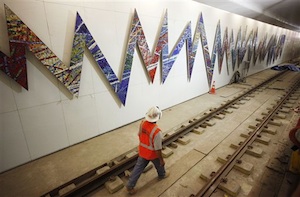

Lend Lease, Skanska and other top New York City contractors accepted surety bonds for a key glass and metalwork subcontractor from an individual surety linked to a Florida businessman known for prior insurance scandals, according to legal documents, interviews with the people involved and an insurance investigator based in England. The bond values for all six projects was about $23 million, for which the subcontractor paid premiums of $850,000.
Starting in June 2012, the subcontractor filed for bankruptcy protection, the individual surety declined to fund its operations and the president of the individual surety said in a legal proceeding that he wasn’t sure how his signature got on company documents related to the bonds.
Although none of the major players in the surety have been charged or convicted of any crime, some of the people involved have links to controversies over fraudulently produced bonds and to other, prior surety related controversies.
The discovery earlier this year of fake Chubb corporate surety bonds has been brought to the attention of federal investigators. But controversies involving individual surety on big public and private projects generally stay out of public view. Last summer's controversy in New York City only recently became known.
The key figure in Diamond Indemnity Trust, which issued bonds for the New York City projects where Lend Lease and Skanska are construction managers, appears to be a man based in West Palm Beach, Fla. At times he has used the names Melde Rutledge, Mel Rutledge, Mel DeRutledge and other variations. He has been linked to surety controversies for more than 10 years, according to Insurance Security Services, an insurance consultancy based in West Sussex, England.
“Mel de Rutledge,” wrote Trevor Jones of Insurance Security Service in 2004, “has been running strange operations for years,” including “false valuation scams” and surety guarantees.
Rutledge's resume includes fraud-related convictions and jail sentences in Washington, D.C. in 1986 and 1989. According to Federal Bureau of Prisons records, Melde Rutledge, Jr. was convicted of interstate transportation of fraudulently obtained property in District of Columbia District Court and sentenced on September 9, 1986 to an original term of six months. After serving the sentence and being released, a judge on December 20, 1989 subsequently sentenced Rutledge to another 14 months of jail time for a probation violation.
Rutledge apparently had scrapes with the law in other states. The Indianapolis Star reported in February 1988 that prosecutors or police had begun an investigation of alleged misuse of student aid funds by "Melde Rutledge, Jr., Fort Wayne, who tried to set up a chain of trade and technical schools."
One of the many companies Rutledge has been associated with has links to individuals involved in the current controversy over faked Chubb surety bonds that have turned up in several states.
Inspirational Names
Consistent with other individual sureties that have come under suspicion, Rutledge appears to operate through a network of companies with trust-inspiring names and he depends on go-betweens who share the premiums. As the asset backing the guarantee, some individual sureties prefer reinsurance, trust receipts and notes secured in institutions whose address may be no more than a mail drop. The true value is often hard to verify. Try to figure out what’s really going on, and confusion reigns.
Rutledge could not be reached for comment. On July 30, a man who answered a cell phone number that Rutledge had used declined to identify himself and said that the number once belonged to Rutledge but no longer does.
Asked about the bankrupt subcontractor and the New York City projects, the man said, “I’m not familiar with that transaction.”
Skanska and Lend Lease officials could not be reached for comment. But an owner of the bankrupt specialty contractor that had the Diamond Indemnity bonds, John Melching, Jr., did give his side of the matter.
Shortly after the bonds were produced, said Melching, his company, Bensalem, Pa.-based American Architectural Inc., a contract glazier and metalwork firm, learned that it owed several million dollars in back taxes to the federal government. The company made substantial payments to the IRS and is disputing the rest of the balance owed, Melching said.
American Architectural contacted the bonding company when its contract for a project at Mt. Sinai Medical Center was near completion and American Architectural had a $400,000 shortfall, said Melching.
Melching said Diamond Indemnity promised to fund the company’s operations during the predicted cash squeeze.
Melching was part of face-to-face meetings about other projects with risk management officials of Skanska and Lend Lease in spring and summer 2012. Darius X. Johnson, an attorney who joined Diamond Indemnity in 2010 as general counsel, also attended, said Melching. In some meetings Rutledge participated by phone.
“Contractors asked about the bonding company’s strength, other ongoing jobs, and Johnson answered well enough to satisfy them,” said Melching. “Darius Johnson would always explain that the bonding company itself, since it was cash bonds, had hundreds of millions of dollars worth of letters of credit with banks like Zurich. As a matter of fact, while we were in negotiations to help us, they presented a letter-of-credit drawn on Deutsche Bank for $100 million."
Diamond Indemnity, claims Melching, “was trying to get my bank to provide $10 million against that letter of credit, cash, and my bank refused to do so.”
Upbeat Until Bankruptcy
Until American Architectural filed for protection from its creditors, “Our discussions were always positive.”



Post a comment to this article
Report Abusive Comment